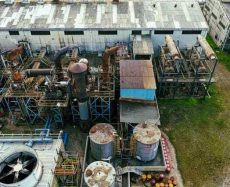
- admin
- April 25, 2019
Underground Fuel Storage Tank Removal Procedure
If you have an unused or out of service underground storage tank on your property, then the thought of leaks can be frightening.
The presence of an unused underground fuel tank can even reduce the value of your property.
Here we’ve discussed about the removal process of underground storage tanks (UST), their potential environmental hazards and the dangers associated with improper removal of them.
As time passes by and the condition of the tank starts deteriorating, the tank begins leaking its residue and becomes a significant threat to the environment.
This makes the removal of a UST more important.
The possible dangers that are associated with tank removal process and the huge risk of the liquids that can contaminate environment have prompted federal and state regulatory agencies to set rules and regulations ensuring licensing requirements and proper removal processes.
The following steps are carried out before removing an UST:
Notify Local and State Government
Local and State Government must be informed about the tank removal plan 30 days prior to the day of removal.
Contact with Licensed Contractor
This rule varies from state to state. Some states have mandated a licensed contractor to execute the removal process.
Complete Liquid Removal from the Tank
Sometimes, a small amount of residual material can be hazardous for the environment. Proper disposal process needs to be followed.
Inert the Tank
An inert tank is less prone to explosion. In this step, the oxygen of the tank is replaced with nitrogen, carbon dioxide or any non-explosive gas.
Begin Excavation
Dig the soil around the tank for easier access to the top of the tank and its associated dispensers or product lines.
Clean the Tank and Remove
For the tank cleaning and residual handling process, perfect planning is required. It includes small spills during pipe disconnection, tank inert, tank cleaning, liquid handling, excavation and finally the removal process.
Tank Disposal
This process depends on the state’s rules. You can transport an intact tank or you can cut it.
Contaminated Soil Management
To carefully handle the contaminated soil, you must follow the Federal or State guidelines.
Sampling Protocol
Some states collect soil samples after the removal. Each state follows their own specific guidelines.
UST Closure Report
The report contains detailed information associated with the removal process, disposal documentation and documentation of contaminated soil disposal.
There are exceptional situations when it’s better not to remove the tank.
If the tank is beneath a building’s foundation, then excavation can harm the building.
In this situation, contractors fill the tank with non-shrinking, solid, inert material such as polyfoam or concrete slurry to keep it as it is.
GSC Tanks manufactures premium quality storage tanks.
Call at 470-589-7790 or visit to https://www.gsctanks.com/ to buy their engineered storage tanks.
- Industrial Storage Tanks
- underground fuel storage tank removal process
Category
- Above Ground Fuel Tanks
- Above Ground Gas Storage Tank
- Above Ground Storage Tanks
- Above Ground Water Storage Tanks
- Agricultural Tanks
- Chemical storage Tanks
- Diesel Fuel Storage Tanks
- Diesel Storage Tanks
- Exernal FloatingRoof Tanks
- Farm Water Tank
- Fiberglass Oil Tanks
- Fiberglass Septic Tanks
- Fiberglass Underground Fuel Storage Tanks
- Field Erected Tanks
- Floating Roof Tank
- Fuel tank
- Industrial Chemical Storage Tanks
- Industrial Gas Tanks
- Industrial Plastic Tanks
- Industrial Storage Tanks
- Industrial Tank heating pads
- industrial tanks
- Natural gas
- Natural gas vs Propane
- oil storage tank
- Oil Storage Tanks
- Peracitic Acid
- Petroleum Tanks
- Residential gasoline storage tanks
- Residential Water Storage Tanks
- Sodium Hydroxide Storage Requirements
- Sodium Hypochlorite Storage Tanks
- Steel Storage Tanks
- storage tank failure prevention
- Storage Tanks
- Sulfuric Acid Tanks
- Uncategorized
- UnderGround Storage Tanks
- Water Storage Tanks

 Tank Size Calculator
Tank Size Calculator






